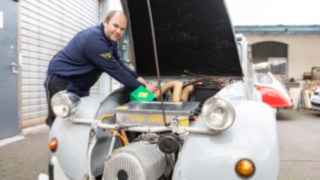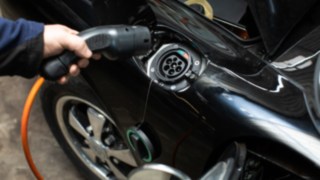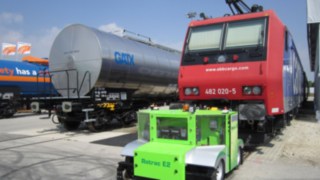From combustion to electric engines
New Life for Old Cars
For more than ten years now, Lorey Maschinenbau GmbH has been fitting old combustion-driven cars with modern electric engines. Whether a Porsche, VW bus, Renault Kangoo or a pre-war Chevrolet, the Offenbach-based retrofitting experts can transform any vintage car into an electric classic using Linde eMotion technology.

Lorey with a beautifully restored Porsche 911— People are always excited to get a look under the hood

Lorey with a beautifully restored Porsche 911— People are always excited to get a look under the hood
Marco Lorey has been making a big impression lately. Whenever he drives to the grocery store for his weekly shopping or picks up his children from school, he is always driving a beautifully restored black Porsche 911, originally built in 1968. Many of the people who see him out and about are immediately intrigued. They come over for a closer look and examine every inch of the elegant speedster. “But it’s when I open the hood that people get really excited,” says Lorey. “That’s when they see that there’s no 6-cylinder engine in the engine compartment as expected, but rather an electric engine.”
Unfortunately, the classy Porsche, which Lorey is currently test driving around Offenbach, does not belong to him. The mechanical engineer has simply been tasked with fitting the classic car with a new electric engine. Since 2007, Lorey Maschinenbau GmbH has specialized in retrofitting older cars with electric engines. Whether a Citroën 2CV, Beetle or Renault Kangoo, a Mercedes W124 Limousine, Fiat 500, Opel Agila, or the legendary VW T-model buses, as soon as a car leaves Marco Lorey’s workshop, the owner can forget about low-emission zones, no-diesel zones and rising petrol prices.
Lorey’s electric passion began with his own Kangoo
Lorey has retrofitted 125 cars to date, mostly for private customers. However, some renowned companies have also become aware of the services provided by the Offenbach specialists and are starting to test the water by requesting modifications for their company cars. Lorey is currently putting an electric engine into an old Land Rover, used by a leading sports goods manufacturer as an exhibition vehicle.

Lorey is converting a Land Rover into an electric vehicle for a leading sports goods manufacturer

Lorey is converting a Land Rover into an electric vehicle for a leading sports goods manufacturer
The idea to remove the old combustion engines from these cars and fit them with modern electric engines came about while Lorey was working on his own renovation project: After his first daughter was born, the family realized they urgently needed a second car. Lorey and his wife were adamant they didn’t want another car with a combustion engine. “We looked around on the market but didn’t find what we were looking for,” recalls Lorey. “Electric cars hadn’t yet taken off. So we thought, we’ll just make one ourselves.”
For his project, Lorey got hold of an old Renault Kangoo, which he fitted with 16 lead-acid batteries. He took the engine and technical components from a forklift truck. The keen tinkerer was able to get everything else—from the required technical knowledge to the necessary manufacturing machines—from his own company: Lorey Maschinenbau GmbH has been producing special machinery since 1927. The employees of the family company, now in the fourth generation of ownership, mill, drill and weld steel and aluminum into workpieces that can be used for industrial and trade purposes and as spare parts for classic cars.

Electric modification—cars built in 2002 or earlier
When the Kangoo passed its test drive in 2007, Marco Lorey knew he had just discovered a new area of business for his company. Electric cars are still quite scarce, but even back then they had some indisputable advantages: The engines are almost entirely wear-free and rarely need any repair work. At the same time, electric cars are much cheaper to run than petrol cars. It only costs between two and four euros for each 100 kilometers traveled. And of course, there’s the feeling of doing something good for the environment.
In theory, according to Lorey, any car can be converted into an electric car. However, his company is focusing more on older cars, built in 2002 or earlier. The newer the car, the harder it is to connect the engine to the increasingly complex on-board electronics. “It can be difficult to get all the information from a complex digital system so that you can control all the components once they are in the retrofitted car,” explains Lorey. Of course, it is possible in principle, but it quickly becomes so expensive that it’s often not worth it for the customer.
This isn’t a problem at all with older cars. In fact, it’s so easy to retrofit them that in some cases, if the customer is a car enthusiast too, Lorey simply supplies them with the parts they need to carry out the modification themselves. The most crucial part for conversion is an adapter plate, which Lorey’s employees mill from a piece of aluminum. The plate connects the new electric engine with the original vehicle transmission and must be purpose-built for every retrofitting job.
Cutting-edge technology from Aschaffenburg

Marco Lorey gets the batteries for his electric retrofitting projects from China

Marco Lorey gets the batteries for his electric retrofitting projects from China
For the energy-storage system, Lorey uses lithium iron phosphate batteries imported from China. Unfortunately, he says, they are not available on the German market: “The Chinese manufacturers are about ten years ahead of us in terms of battery technology.” It is also the batteries that make up the lion’s share of the costs. Depending on the required range and top speed, a retrofit can cost between 10,000 and 20,000 euros.
Apart from the batteries, Lorey uses only technology that is made in Germany. Since as early as 2009, he has been getting his electric engines and control electronics for all his retrofitting projects from Linde eMotion. The idea for this collaboration originally came from the Aschaffenburg-based electric specialists, which Lorey is still thrilled about today:
We are really pleased that Linde approached us. We would never have thought of asking such a big company to work with us.

Lorey Maschinenbau GmbH relies on engines from Linde eMotion when converting old cars with combustion engines into electric cars

Lorey Maschinenbau GmbH relies on engines from Linde eMotion when converting old cars with combustion engines into electric cars
The collaboration with Linde eMotion quickly solved a key problem: “With other suppliers, we would have had to take more than 1000 engines per order to get an affordable unit price. For a small company like us, that was completely unrealistic. But with eMotion we have found a partner with outstanding technology which can also deliver suitable quantities of the parts.” And that isn’t the only advantage of the collaboration: “We quickly realized how good the Linde engines are and how efficiently they run. This enabled us to significantly increase the overall efficiency of the cars.”

Since 2009, Lorey has been sourcing engines and control electronics from Linde eMotion

Since 2009, Lorey has been sourcing engines and control electronics from Linde eMotion
In the beginning, Lorey worked closely with Linde eMotion, particularly when it came to unusual customer requests. Engineers and programmers were on hand to help adapt each component perfectly to the vehicle. But this sort of fine-tuning is rarely necessary now: “Over the years we have optimized our work processes to the extent that we only need to order the engines and control technology for the specified performance from eMotion, and then we get everything we need delivered to us, ready to go.”

Marco Lorey, Managing Director at Lorey Maschinenbau GmbH and Wolfgang Klüpfel, Head of Linde eMotion (left)

Marco Lorey, Managing Director at Lorey Maschinenbau GmbH and Wolfgang Klüpfel, Head of Linde eMotion (left)
Climate debate brings the orders flooding in
More than ten years on, Lorey Maschinenbau GmbH’s reputation as an experienced electric retrofitter precedes it—and not just in Germany either. In a wildlife park in South Africa, an all-terrain vehicle retrofitted in Offenbach drives among the animals almost without making a noise, giving visitors the chance to see them up close. Orders from other European countries are also on the rise.
It’s clear that people are becoming more engaged in the climate debate. Even those who aren’t keen tinkerers are now deciding to replace their old combustion engine with a new drive.

Marco Lorey loves being able to tinker with electric classic cars

Marco Lorey loves being able to tinker with electric classic cars
“Our customers come from every age and income group,” says Lorey. The motivations for converting the engines can vary widely too: “They’re not all Green voters who are doing it for the environment. Many do it so they can be self-sufficient. They don’t want to be dependent on either the automotive industry or the oil giants.” Even so, the climate debate is certainly making an impact on Lorey’s order book. The company is now receiving new orders almost every day. “It’s clear that people are becoming more engaged in the climate debate. Even those who aren’t keen tinkerers are now deciding to replace their old combustion engine with a new drive.”
Lorey is particularly excited whenever real rarities come into his workshop. Such classics include a 1925 Chevrolet imported specially from the USA, which has recently begun a new life as an electric classic. “These sorts of cars are usually only found in museums, where you can’t even touch them,” gushes Lorey. “But I was able to tinker with the car and even take it out for a spin. You can’t beat that.”








